You searched for: FACEBOOK代全世界推广开户【TG飞机:@bapingseo】谷歌seo网站推荐【TG电报:@bapingseo】尼日利亚做广告【Telegram:@bapingseo】128棋牌下载hi合乐888手机?20220707j5C1Wb.html
<< Previous | Displaying results 601-650 of 1617 for "FACEBOOK代全世界推广开户【TG飞机:@bapingseo】谷歌seo网站推荐【TG电报:@bapingseo】尼日利亚做广告【Telegram:@bapingseo】128棋牌下载hi合乐888手机?20220707j5C1Wb.html" | Next >>
-
Avreml the Pickpocket
SongMordecai Gebirtig, born in 1877 in Krakow, Poland, was a Yiddish folk poet and songwriter. Gebirtig had three daughters, for whom he wrote and performed his poems. The words were set to improvised melodies, and most of his songs resemble entries in a diary. Many of Gebirtig's poems contain themes of eastern European Jewish life in the 1920s and 1930s. The lyrics to "Avreml the Pickpocket" address two social issues, crime and the collapse of family life, arguing that both find their roots in poverty and…
-
Deggendorf Songbook
Timeline EventDecember 1, 1945. On this date, survivors of the Deggendorf displaced persons camp gave a songbook to the UNRRA director Carl Atkin.
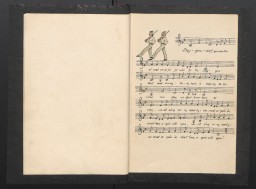
-
Death of German President von Hindenburg
Timeline EventAugust 2, 1934. On this date, Adolf Hitler became President of Germany after Paul von Hindenburg's death.
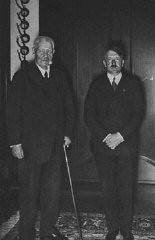
-
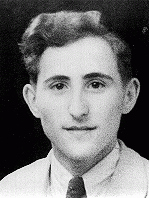
-
The Nazi Party
ArticleThe National Socialist German Worker’s Party, also known as the Nazi Party, was the far-right racist and antisemitic political party led by Adolf Hitler.

-
Combating Holocaust Denial: Evidence of the Holocaust presented at Nuremberg
ArticleAt the Nuremberg trials, Allied prosecutors submitted documentation left by the Nazi state itself. This evidence is a lasting refutation of attempts to deny the Holocaust.

-
Drawing of the SS Patria
ArtifactDrawing of the SS Patria, part of the illustrated diary of Egon Weiss which he compiled during and immediately after his detention in the Atlit internment camp.
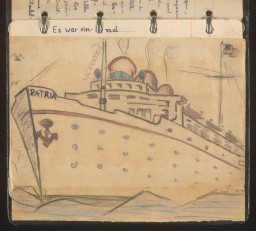
-
Defendant Wilhelm Keitel
PhotoDefendant Wilhelm Keitel, former Chief of the German Armed Forces, in his Nuremberg prison cell.
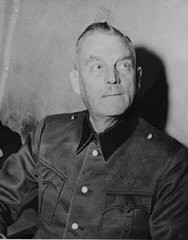
-
Hitler arrives at the Olympic stadium
PhotoAn enthusiastic crowd greets Adolf Hitler upon his arrival at the Olympic Stadium. Berlin, Germany, August 1936.
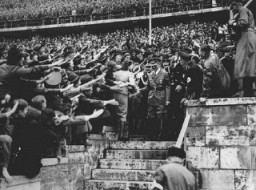
-
Hitler reviews troops
PhotoAdolf Hitler reviews SA troops celebrating the third anniversary of his assumption of power. Berlin, Germany, February 20, 1936.

-
Vidkun Quisling
PhotoVidkun Quisling, pro-German Norwegian Fascist leader. Pictured here addressing supporters of his Norwegian Nazi party at a rally. Oslo, Norway, August 1941.

-
Eva, Alfred, and Leane Munzer
PhotoEva, Alfred, and Leane Munzer. Infant Alfred survived in hiding; his sisters were discovered and killed in Auschwitz.
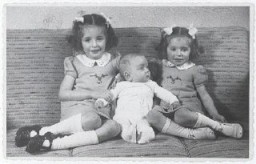
-
Portrait of Ernest Hemingway
PhotoErnest Hemingway in his World War I Red Cross Ambulance Corps uniform, ca. 1918.
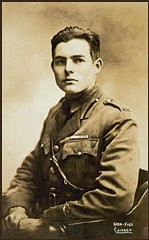
-
Defendant Adolf Eichmann on trial
PhotoDefendant Adolf Eichmann takes notes during his trial in Jerusalem in 1961.
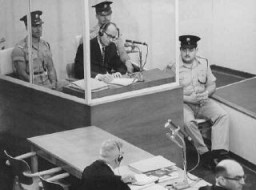
-
Jehovah's Witness Franz Kusserow
PhotoFranz Kusserow, a Jehovah's Witness, was imprisoned for nine years for his religious beliefs. Bad Lippspringe, Germany, ca. 1950.
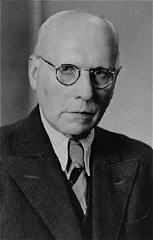
-
Annexation of Austria
PhotoAdolf Hitler and his entourage view a military parade following the annexation of Austria (the Anschluss). Vienna, Austria, March 1938.
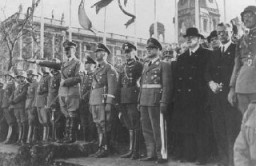
-
Singer Simon Bikindi
PhotoSinger Simon Bikindi sits at the International Criminal Tribunal for Rwanda during his trial for incitement to genocide. Arusha, Tanzania, April 4, 2002.
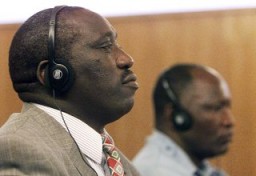
-
Dwellings in a Roma (Gypsy) encampment in Haarlem
PhotoA man works outside his family's dwelling in a Roma (Gypsy) encampment in the city of Haarlem. The Netherlands, October–November 1940.

-
Thomas at age 13 months
PhotoThomas at age 13 months with his father, Mundek Buergenthal. Czechoslovakia, June 1935.
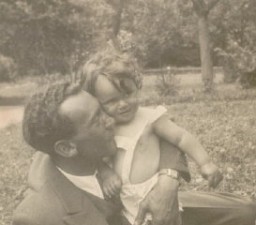
-
Sculpture memorializing Janusz Korczak
PhotoA wall sculpture memorializing Polish Jewish doctor Janusz Korczak resides on the exterior of a teaching hospital that bears his name, Olsztyn, Poland.
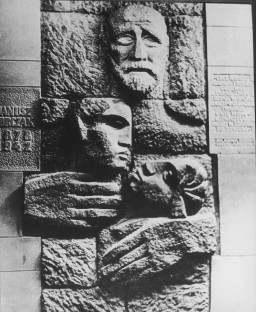
-
Pastor Martin Niemöller
PhotoPastor Martin Niemöller speaks to reporters after his release from a concentration camp. Germany, 1945.

-
Philipp Bouhler
PhotoAdolf Hitler tasked Philipp Bouhler, the director of his private office, and Karl Brandt with co-leading the “euthanasia” program.
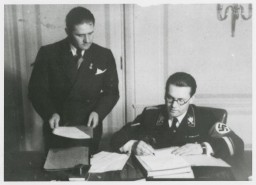
-
Ezra Zelig Szabasson
ID CardEzra Zelig, who was called Zelig by family and friends, worked in the lumber business in Kozienice, a village by the Kozienice birch forest. He was married and the father of six children. A prominent member of the community, Zelig served on Kozienice's city council, and was also president of the local Zionist organization. 1933-39: In 1937 Zelig tried to obtain visas for his family to immigrate to Palestine [the Yishuv], at that time a British protectorate, but was unsuccessful because of the…

-
Lewek Szabasson
ID CardLewek and his five brothers and sisters were born to religious Jewish parents in the town of Kozienice, situated in east central Poland near a birch forest. Lewek's father owned a sawmill, and when Lewek and his brothers were grown, they helped their father manage the family business. 1933-39: When Lewek was 15 he attended an agricultural school near Kozienice, because he wanted to immigrate to Palestine [Aliyah] to work the land. But after the Nazis rose to power in Germany in 1933, immigration…

-
Abraham Soep
ID CardAbraham, known as "Bram," was born to a religious Jewish family in Amsterdam. After graduating from high school, Bram went into the diamond business with his father. By 1924 he and his wife, Tonie, had three children. Bram served as president of the Amsterdam Jewish community. 1933-39: The Soeps had a large and comfortable home. Bram and his wife often traveled abroad, and each summer the family rented a home near the seashore in Zandvoort. In 1937 Bram's son Benno joined him in the diamond…

-
Wladyslaw Piotrowski
ID CardWladyslaw was born to Catholic parents in Russian-occupied Poland. He grew up in Plock, a town located in a rural area north of Warsaw. Wladyslaw married in 1918 and he and his wife, Marie, raised four children. 1933-39: Wladyslaw worked as a bookkeeper, and then as an accountant for a local farmers' cooperative. In 1931 he was sent to the town of Wyszogrod to close a failing branch of the farmers cooperative. A year later, he organized a new, successful cooperative in Wyszogrod with local farmers and…
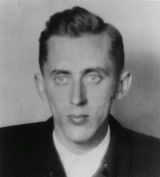
-
Bernhard Liebster
ID CardBernhard, who was from a religious Jewish family in the Polish town of Oswiecim, emigrated as a young man to Frankfurt, Germany. There he married Bertha Oppenheimer from the nearby town of Reichenbach. They settled in Reichenbach where they were one of 13 Jewish families. Bernhard worked as a shoemaker, and the couple raised three children. 1933-39: In a corner of his living room, Bernhard ran a small shop specializing in orthopedic shoes. Antisemitism was growing in Germany, but the townspeople of…
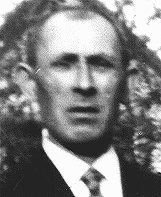
-
Robert Oelbermann
ID CardIn 1919 Robert and his brother Karl founded the Nerother Bund youth group in the Cologne region. Like other German youth groups, it aimed to bring youth closer to nature through camping and hiking. Homosexual relationships sometimes developed from the intense adolescent male camaraderie, and the Nerother Bund accepted these friendships, as did a number of German youth groups at the time. 1933-39: Soon after the Nazis took power in 1933, they dissolved all independent youth groups and urged the members to…
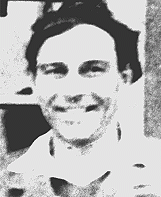
-
Benjamin Soep
ID CardBenjamin, called "Benno" by his family and friends, grew up in a religious Jewish household in Amsterdam. Benno's father, a successful diamond manufacturer, was president of the Amsterdam Jewish community. Benno had two younger sisters and enjoyed collecting stamps. 1933-39: After he obtained some work experience in a department store, Benno joined his father in the diamond business. Benno adhered strictly to Jewish law. He loved tennis and skiing, and in 1938, while skiing in Switzerland, he met a girl…
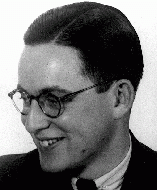
-
Robert T. Odeman
ID CardBorn Martin Hoyer, Robert took Robert T. Odeman as his stage name when he began a professional career as an actor and musician. A classical pianist, Robert gave concerts throughout Europe, but a hand injury tragically ended his concert career. 1933-39: In 1935 Robert opened a cabaret in Hamburg. One year later the Nazis shut it down, charging that it was politically subversive. Robert then moved to Berlin where he developed a close relationship with a male friend who was pressured to denounce Robert to…
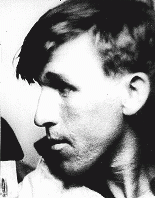
-
Herman Judelowitz
ID CardHerman was the oldest of nine children born to a Jewish family in the Latvian village of Aizpute. He was a World War I veteran, and after the conflict, in 1918, he fought for the establishment of a free Latvian republic. Two years later he married Sarah Gamper and they settled in the city of Liepaja, where they owned a shoe store. By the late 1920s they had two daughters, Fanny and Jenny. 1933-39: Herman designed patterns for the uppers of shoes, which he used to fashion into finished shoes. His shoe…
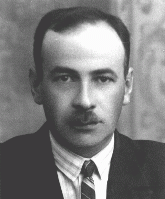
-
Jeno Katz
ID CardOne of eight children, Jeno was born to religious Jewish parents in the northeastern Hungarian town of Buj. The family later moved to the village of Zalkod, where Jeno's father ran a general store. His schooling over, Jeno became a cabinet maker. After he married, he and his wife Eloise settled down in Sarospatak, a picturesque town with a ruined medieval fortress and the Windischgratz castle. 1933-39: Jeno's sister Sadie, who had immigrated to the United States, came to visit her parents in Zalkod. At…
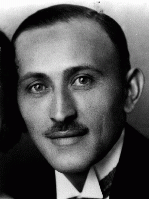
-
Curt Egon Rosenberg
ID CardCurt was the oldest of three children born to a Jewish family in the famous German university city of Goettingen. His father owned a linen factory that had been in the family since it was founded by Curt's grandfather. Goettingen had a small Jewish population, with only one synagogue. Curt attended public school in the city. 1933-39: The Nazis came to power in 1933. A year later, the Rosenbergs' factory was seized and the family was forced to move to Hamburg. Because he was Jewish, Curt was arrested in…
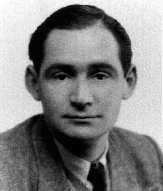
-
Alfred (Fredl) Krakauer
ID CardAlfred was the fifth of six children born to Jewish parents in a small town in Moravia, where his father ran a dry-goods and clothing store. The Krakauers spoke both Czech and German at home. In 1929 and 1930, after graduating from secondary school, Alfred served in the Czechoslovakian army. He enjoyed skiing and also played soccer for the Maccabi Jewish team. 1933-39: Alfred graduated in 1934 from Prague's Industrial School for Art. He became a graphic artist and decided to remain in Prague because of…
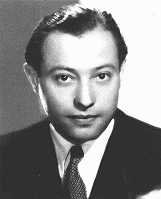
-
Abraham Lewent describes performing forced labor in Warsaw and increased Polish antisemitism
Oral HistoryLike other Jews, the Lewents were confined to the Warsaw ghetto. In 1942, as Abraham hid in a crawl space, the Germans seized his mother and sisters in a raid. They perished. He was deployed for forced labor nearby, but escaped to return to his father in the ghetto. In 1943, the two were deported to Majdanek, where Abraham's father died. Abraham later was sent to Skarzysko, Buchenwald, Schlieben, Bisingen, and Dachau. US troops liberated Abraham as the Germans evacuated prisoners.
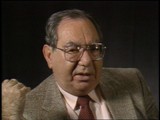
-
1931 studio portrait of Abraham Moshe Muhlbaum
PhotoAbraham and his family fled from Berlin to Amsterdam in October 1938. They found refuge in the Netherlands until January 28, 1943, when all the members of the Muhlbaum family, except Abraham, were deported to Westerbork. Abraham escaped over the rooftops during the round-up. He gradually established a new life as a member of a Dutch resistance group that included Joop Westerweel. In 1944, Abraham was arrested as a member of the resistance (his Jewish identity remained hidden). He was held…
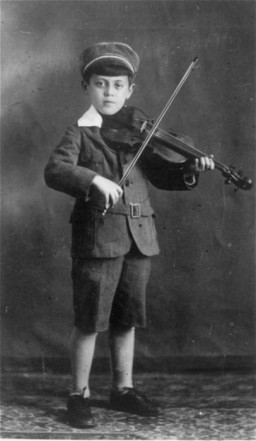
-
Elie Wiesel: Days of Remembrance excerpts
ArticleExcerpts from Elie Wiesel's addresses during US Holocaust Memorial Museum Days of Remembrance commemorations in 2001, 2002, 2003, and 2004.
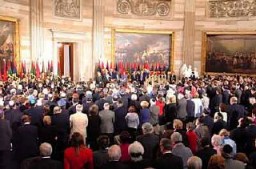
-
SS: Key Dates
ArticleKey dates in the history of the SS (Schutzstaffel; Protection Squadrons), charged with the leadership of the “Final Solution,” the murder of European Jews.

-
Theresienstadt: Establishment
ArticleLearn about the establishment of the Theresienstadt camp/ghetto, which served multiple purposes from 1941-45 and had an important propaganda function for the Germans.

-
Emigration and the Evian Conference
ArticleIn July 1938, 32 nations met in Evian, France, to discuss immigration policies for Jewish refugees fleeing Nazi Germany. Learn how these discussions impacted Jewish lives.
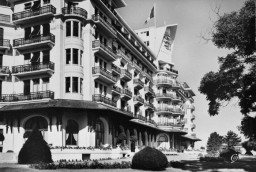
-
Nazi Terror Begins
ArticleAfter rising to power in January 1933, the Nazis began the process of moving Germany from a democracy to a dictatorship. Learn more.

-
The War Refugee Board
ArticleThe War Refugee Board was formed in 1944 by executive order under President Roosevelt. It was tasked with the rescue and relief of victims of Nazi oppression.

-
Resistance inside Germany
ArticleSome individuals and groups in Germany attempted to resist Nazism, despite the risk of being caught and facing punishment. Learn more about their efforts.
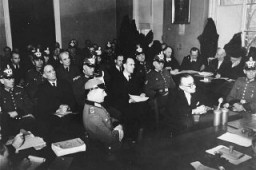
-
Purim
ArticleLearn about the background and traditional observances of Purim, a Jewish holiday marking the deliverance of the Jews from a royal death decree.
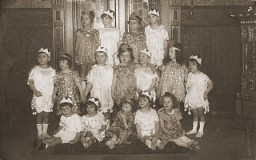
-
German Military Oaths
ArticleIn Nazi Germany, German military personnel swore an oath directly to Adolf Hitler. Learn about the oath and its impact.
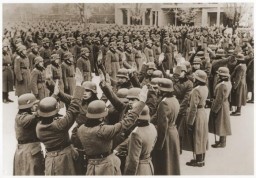
-
Reich Security Main Office (RSHA)
ArticleThe Reich Security Main Office (RSHA), created by Heinrich Himmler, brutally coordinated and perpetrated many aspects of the Holocaust.

-
Persecution of Roma (Gypsies) in Prewar Germany, 1933–1939
ArticleBeginning in 1933, the Nazis persecuted Roma (often pejoratively called “Gypsies”) based on underlying prejudices and racism. Learn how this harassment escalated to genocide.

-
Hungarian Jewish Businessman Begins Issuing Papers to Jewish refugees
Timeline EventAugust 25, 1942. On this date, George Mandel-Mantello began issuing Salvadoran citizenship papers to Jewish refugees in Nazi-occupied Europe.
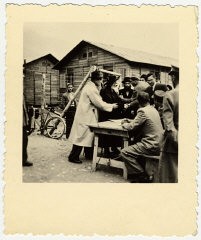
-
“Czech Family Camp” at Auschwitz Liquidated
Timeline EventJuly 11, 1944. On this date, the liquidation of the "Czech family camp" in Auschwitz took place. Michael Kraus later described the event in his diary.
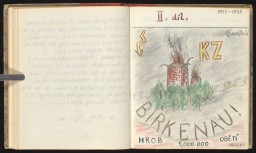
-
Page from Earl G. Harrison's Notebook
Timeline EventJune 4, 1945. On this date, Earl G. Harrison toured displaced persons camps and wrote of his impressions of Linz, Austria.

